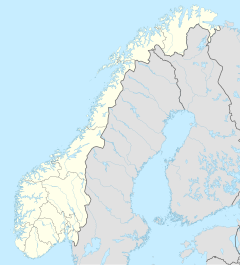Reisa National Park
| Reisa National Park | ||
|---|---|---|
|
|
||
| Location: | Troms og Finnmark , Norway | |
| Next city: | Tromso | |
| Surface: | 806 km² | |
| Founding: | 1986 | |
| The national parks in Northern Norway (The Reisa has number 24) | ||
| The Reisadalen | ||
The Reisa National Park ( Norwegian Reisa nasjonalpark , Samisch Njállaávzi nasjonalpark ) is a Norwegian national park , which is mainly located in Reisadalen . It covers an area of 806 km², belongs to the municipality of Nordreisa and is located north of the Arctic Circle in the province of Troms og Finnamrk . The park covers the upper part of the Reisaelva and runs along the border with Finland . On the Finnish side, the park turns into several nature reserves. In the east, is already in the province of Finnmark , the Finnmarksvidda - plateau . In the west, the Reisa National Park borders the 80 km² nature reserve Ráisduottarháldi , in which the Raisduottarhaidi mountain range is also located.
The park was founded in 1986 to preserve and protect the beautiful and almost untouched mountain landscape with its valleys, flora and fauna and geological conditions. In terms of biodiversity, the vegetation is one of the most luxuriant in Norway.
Geography, landscape and geology
The park is located in the highlands of the southeastern part of the province of Troms og Finnmark. The largest river is the Reisaelva, which also has its source in the park. In the course of the Reisaelva there is the 269 meter high Mollisfossen waterfall, whose free fall height is 140 meters. In the vicinity of the Reisaelva there are also numerous glacier pots , some of which are up to 10 meters deep. In general, the landscape of the Reisa National Park is very reminiscent of the Altadalen .
In the mountains north of the Imofossen waterfall, there are sometimes very large canyons , in which you can see the many different rock deposits. The mountains become flatter towards the Finnish border and the landscape is dominated by heather and moorland .
Flora and fauna
Due to the diverse and fertile soils, the flora is one of the most biodiverse in Norway. There are both basic and acidic soils. A total of 525 plant species have been discovered in the park. Of 230 alpine plants in Norway, 193 are found in Reisa National Park. The rarest plant species are blue sky ladder , upright lice weed , square scale heather , alpine carnica and Alaska rhododendron . Trisetum subalpestre , Silene involucrata , Lactuca sibirica , Lysiella oligantha and coral root can only be found in Elvedal . Lysiella oligantha is very rare in all of Northern Europe. The only larger deposits worldwide are on Lake Baikal in Siberia .
There are several species of birds of prey in the national park, including the buzzard , golden eagle , hawk owl , kestrel and gyrfalcon . Sometimes you can also see sea eagles in the park. Total life around 140 bird species in the park, including the rather rare star and black-throated divers and Bean Goose , Lesser White and whooper swan .
The largest mammals are wolverines , lynx and arctic fox . The Sami name of the national park means arctic fox gorge national park (njalla = arctic fox). However, the arctic fox population is declining in the park. As a rare visitor, brown bears come from time to time .
heritage Site
Three major ethnic groups live in and around the national park, the Sami , Kven and Norwegians . All groups have lived there for many centuries, the Sami at least since the 16th century. An exhibition in the Halti National Park Center is dedicated to the Kven culture .
Until the 19th century, the most important industries in the region were logging and tar burning . In some places you can still see the remains of the former tar extraction facilities.
Tourism and administration
There are some unmanaged huts in the park, such as the Nedrefosshytta , which is operated by the Norwegian Trekking Association and is located on the Nordkalottruta . In the east of the park there is also a hut by Lake Ráisjávri .
The lower part of the Reisaelva is particularly suitable for fishing, as there are large populations of salmon (during spawning time), bullhead , sea trout and char . However, licenses are required for fishing and hunting.
photos
See also
Web links
- Information about the area
- Protection regulations in the national park (German) ( Memento from May 25, 2007 in the Internet Archive )
- National Park Center
- Information sheet on the Reisa National Park.
- further information about the Halti nasjonalparksenter (norw.)
literature
- Tom Schandy, Tom Helgesen: 100 norske naturperler. Forlaget Tom & Tom, Vestfossen 2008, ISBN 978-82-7643-430-9 (also available in English).







